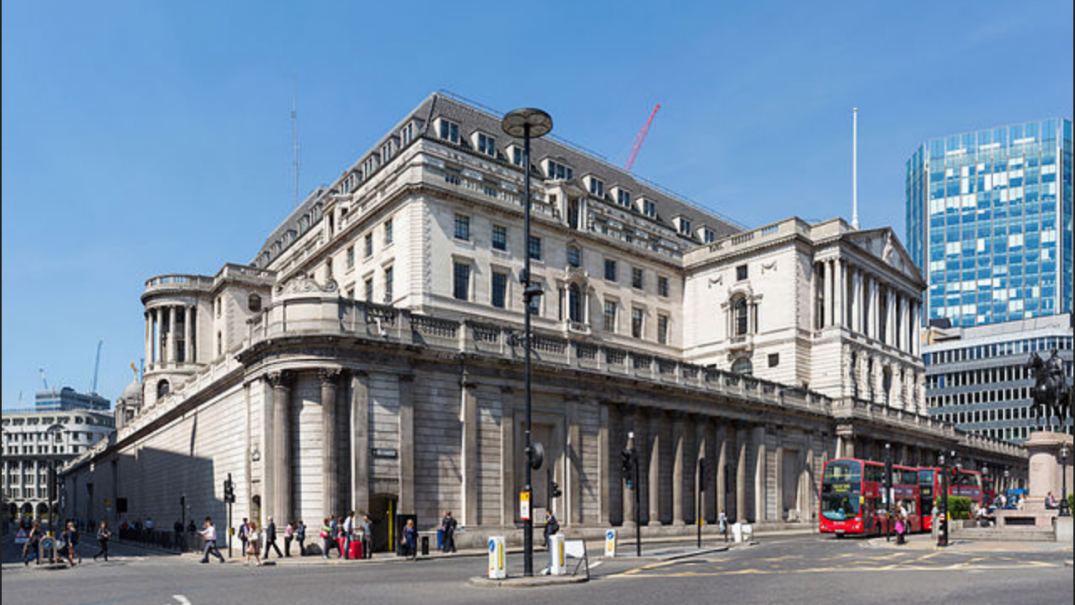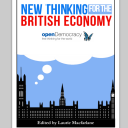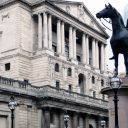Monetary policy post-Brexit: more of the same and why it won’t work

Bank of England, by Diliff.
It is evident that special factors flowing from the decision on BREXIT affect British economic policy, but the UK is not alone in having relied on monetary instruments to stabilise its economy after the financial crisis of 2008. Both the US Federal Reserve and the European Central Bank have pursued a similar path and all the key Central Banks now face the same set of problems. In the UK a policy of fiscal austerity was imposed by government whereas the Eurozone countries were required to operate within the discipline of the so-called Stability Framework. The latter restrained the use of fiscal policy as an instrument of economic stabilisation and as a result many countries in the euro zone have had years of anaemic growth and high levels of unemployment.
Apart from the Guardian most commentators expect the economic situation post BREXIT to worsen. Exactly why the Guardian has taken the rather rosy view of the impact of BREXIT is unclear although one of its most informed commentators (Will Hutton) has outlined in ‘Don’t be fooled. There will be damaging fallout from Brexit’ exactly why the country faces severe and worsening economic conditions due to BREXIT. In this respect Hutton is very much in line with the Bank of England which in its August 2016 Inflation Report set out its analysis of the effects of BREXIT and announced changes in monetary policy. The Bank concluded, ‘the outlook for growth in the short to medium term has weakened markedly…[with] a downward revision of the economy’s supply capacity… and eventual rise in unemployment’.
The Bank predicts little growth during the second half of 2016 with further declines in business investment and weaker levels of personal consumption. Business investment was already falling prior to the EU referendum and continuing uncertainty is expected to depress it further. Against a background of continued weakness in the balance of payments where in Q1 of 2016 the deficit on the current account was 6.9% of GDP and likely to worsen further in the coming months. Furthermore the fall in the exchange rate will have an impact on disposable real income due to rising import prices and their effects on domestic costs of production, and thus depress domestic consumer expenditure.
Given this economic scenario what has the Bank proposed? In summary it is the following:
The Bank of England’s Monetary Policy Committee (MPC) sets monetary policy to meet the 2% inflation target, and in a way that helps to sustain growth and employment. At its meeting ending 3 August 2016, the MPC voted for a package of measures designed to provide additional support to growth and to achieve a sustainable return of inflation to the target. This package comprises: a 25 basis point cut in Bank Rate to 0.25%; a new Term Funding Scheme to reinforce the pass-through of the cut in Bank Rate; the purchase of up to £10 billion of UK corporate bonds; and an expansion of the asset purchase scheme for UK government bonds of £60 billion, taking the total stock of these asset purchases to £435 billion. The last three elements will be financed by the issuance of central bank reserves.
What is one to make of these proposals? Inflation is presently not a problem although the effects on prices from the fall in sterling against other currencies will inevitably feed through into costs and prices at some point. More worrying for future levels of inflation is the impact of Quantitative Easing [QE] where a further expansion of £60 billion is proposed on top of the enormous increases since 2009 – taking the total to £435 billion. Furthermore the purchase of corporate bonds and the new Term Funding Scheme to reinforce the cuts of Bank Rate to 0.25% will also add to domestic liquidity.
It is also worth noting that in July the Bank announced further cuts in banking reserve requirements so as ‘to lower the countercyclical capital buffer rate from 0.5% to 0% of banks’ UK exposures [which] will support lending to households and companies’. The effects of all this monetary easing are totally unpredictable and the Bank’s rationale unconvincing in the light of recent experience.
On QE the Bank has written that, ‘cash injections lower the cost of borrowing and boost asset prices to support spending and get inflation back on target’. Possibly it does to a degree but does one really believe that the economic benefits of QE derived through changes in asset prices are worth the potential future cost in terms of inflation? QE has certainly been a major factor in house price inflation where the cost of housing (both to buy and to rent) is massively out of line with incomes, with all sorts of negative externalities (including increasing rates of homelessness and massively increased expenditure by the state on housing support). Households are as a result having to pay a much higher percentage of their income on housing.
No one (apart perhaps from the Bank) really believes that a worthwhile expansion of domestic demand is feasible and desirable through the wealth effects of rising asset prices as stock markets have also boomed due to QE and house prices rocketed. If one wants to boost domestic expenditure so as to increase demand then fiscal policy is surely the preferred instrument of policy and not the blunderbuss of monetary easing.
The other key change is the further reduction in short term interest rates which were already at historically low levels. It is hard to believe that a further cut of 0.25% is likely to lead to any increase in long term business investment which has been generally depressed since the financial crisis of 2008/9. In the conditions of market uncertainty, intensified by BREXIT, it seems highly unlikely that firms will want to borrow and invest with major and continuing consequences for growth and for employment. Indeed there is doubt about whether the cuts in Bank Rate will actually be passed on by financial institutions which is the rationale for the new Term Funding Scheme which is to ‘reinforce the transmission of Bank Rate cuts.’
The evidence of past behaviour by banks would leave one sceptical about any cut in Bank Rate leading to a fall in lending rates especially given the current pressure on bank profits. Financial institutions are much more likely to pocket the cut in Bank Rate rather than pass it on to their customers – both business and private. After all QE itself puts downward pressure on bank profits. Many important institutions are facing severe financial problems directly as a result of current monetary policy, with pension funds experiencing severe deficits and increasingly exploring risky investment strategies. For pensioners this will mean much reduced pensions compared with what had been expected with levels well below what are considered adequate for retirement.
Another key question is how will households respond to the cut in Bank Rate assuming that this in part is passed on in lower lending rates. Here there is also great uncertainty in part because falling output will further depress employment which will have some negative effect on disposable income. Much more important will be the direct and indirect impact of rising import prices on real disposable incomes as the 10% fall in sterling exchange rates so far feeds through into prices. These depressive forces will be strengthened by the impact of even lower interest rates on savings which are already so low as to have adversely affected incomes, especially of pensioners, and thus have added to the slow growth in domestic demand in recent years.
The Bank argument that falling interest rates will lead to dissaving looks very unconvincing given the general uncertainty created by BREXIT and savers are likely if anything to cut back on expenditure rather than spend. Even more worrying is the effect of continued extremely low interest rates on the whole culture of savings in the medium to long term since it must surely be an objective of policy to encourage savings for retirement rather than have these costs fall on the state. There can be no doubt that current policies have had significant distributional effects since continuing low interest paid to savers have in effect subsidised borrowers thus inducing a growth in both secured and unsecured debt that is unsustainable.
Also imponderable is how will personal borrowers respond to yet another cut in short term interest rates – whether there will be a greater demand for both secured (mainly mortgage debt) and unsecured credit (on bank cards and so on). It can be assumed that the last thing the Bank wants to encourage is yet further speculation in housing funded by lower interest rates on mortgage debt and easier access to it as a result of QE (which expands bank and building society deposits – assisted by the new Term Lending Scheme). Given the more or less fixed stock of housing and the excessive pressure already in some regions (London and the South East) more mortgage financed expenditure which will merely raise housing costs even further.
Many households since 2009 have been encouraged by low interest rates on mortgages and their plentiful supply to take on large amounts of additional debt so that the ratio of mortgages to income is now extremely high. Any increases in interest rates are thus likely to cause immediate problems with repayments and thus lead to possibly catastrophic falls in house prices. This is a potentially significant effect of any shift in monetary policy away from low interest rates, and yet the Bank may be forced by the state of the external balance to raise these so as to finance a continuing current account deficit by encouraging capital inflows.
There are already some signs that parts of the housing market are feeling the negative effects of BREXIT (especially luxury flat purchases by foreigners who now face much more exchange rate uncertainty and greater probability of property price declines). One would anticipate that domestic borrowers are not likely to take on much more mortgage debt given the existing excessive ratio of borrowing to income and the much greater uncertainty about the path of personal incomes and future house prices.
How about unsecured borrowing? Here it needs to be recalled that total unsecured debt in the UK by households (excluding mortgage debt) rose by £48 billion in 2012-2015 to a total of £353 billion in 2016. So during the years after the financial crash when personal incomes were squeezed and real wages fell in the UK (more than in all the other OECD countries other than Greece) households responded by taking on additional debt. The scale of the problem is such that a report by the TUC found the following:
Overall, 11 per cent of households holding any form of unsecured debt are estimated
as over-indebted in 2015, more than double compared to the 5 per cent in 2012. Of
the over-indebted households, half are extremely over-indebted and so paying out
more than 40 per cent of their income to their unsecured creditors. In total, 3.2 million households or 7.6 million people are over-indebted, an increase of 700,000 or 28 per cent since 2012. On this basis nearly one in eight of all UK households are currently over-indebted. Likewise, 1.6 million households are in ‘extreme debt’.
It seems highly unlikely and highly undesirable as an object of economic policy to encourage yet further borrowing by a personal sector that is already highly leveraged. So where is the domestic demand growth going to come from if the economy is not to enter a deep recession? As noted above the business sector faces such uncertainty and such weak demand growth that they will not seek to expand their stock of fixed assets. While there might be some demand [net] as a result of the fall in the exchange rate this will depend on the trading arrangements finally concluded as a result of Brexit and be highly uncertain. Monetary policy under present conditions mirrors exactly the state that Keynes wrote about in the General Theory where there exists a ‘liquidity trap’ such that easing monetary conditions simply leads to the holding of excessive balances and a weak demand response [at best].
Key Policy Choices for UK
What needs to happen? Firstly, the British government needs to make it clear now that it will seek a permanent and ongoing trading relationship with the EU that as far as possible retains the existing set of arrangements. Anything else will leave the economy floundering in a world of uncertainty that will lead to falling output and rising unemployment – both avoidable. The EU referendum has already worsened the economic performance of the UK and economic policy needs to be re-set so as to sustain output and employment. We already have lower interest rates than other countries so there is no mileage in further cuts into negative territory for reasons marshalled above.
Secondly, the government needs to re-establish growth through a fiscal and industrial strategy that meets the needs of the country rather than one which is ideologically based. If the UK is to be able to compete in a globalised world then it needs public investment in both infrastructure and in human capital. It is precisely at a time of historically low interest rates that the government should expand its investment expenditure, through borrowing mainly and through higher taxation on the top 1%. The UK cannot possibly compete with China and the rest of Asia in terms of labour costs and cuts in nominal [and real] wages on the scale needed to do so are infeasible. So there is no choice but to invest in skills, training and education if UK is to remain a major trading country.
Finally, the argument that increasing the public debt will be inflationary has been shown to be a fable. During the period of the Cameron government, fiscal policy was a significant drag on the economy – totally unjustified in terms of constraints in financing borrowing in the capital markets. One consequence of neo-liberal fiscal policy was a major cutback in the level of public investment which is so essential for inducing and supporting investment by the private sector. It is unsurprising that productivity slowed further since the financial crisis of 2008/9 given the setting of fiscal policy which was based on rolling back the state. Yet the activities of the state are so critical for inducing productivity growth directly through its investment in people and in infrastructure.
Conclusions; policy choices for Europe
The key question now facing all of the Central Banks is how to re-establish more normal monetary conditions and when to do so. Clearly at some point rates of interest will have to be ‘normalised’ in all of the main countries but how to bring this about and what levels should be established are matters of judgement. The attempt by the Bank of England recently to establish a new lower rate of interest (noted above) was largely frustrated because insurance companies and pension funds (and other institutions) did not want to exchange existing holdings of government debt for cash. So it is not obvious how easy it will be through open market operations for Central Banks to actually move to higher interest rates and the process of trying to do so will probably bankrupt them. Currently the Bank of England and the European Bank are holding huge stocks of debt that they have purchased and in order to push up interest rates they will have to sell this debt with capital losses.
Perhaps more important are the effects on economic and social systems of moving to higher levels of interest rates in the near future. In part Central Banks have been using changes in the level of rates as a means of influencing their exchange rate – a beggar my neighbour policy that is generally condemned, but that doesn’t prevent countries from doing it. Of course shifting to higher interest rates has the potential for causing widespread economic and social distress. To what extent other countries in the EuroZone will be similarly affected by rising interest rates is unclear but there would inevitably be widespread economic disruption. Given the already high levels of unemployment in Italy, Spain, Portugal and France any further fall in demand caused by higher interest rates would be disastrous.
There is, finally, the question that has been raised by Larry Summers which is whether we are facing in the US and Europe a set of structural conditions where for years to come output and incomes will grow much more slowly than in the past. A similar set of predictions were made during the Great Depression of the 1930s but the expected impact never materialised. As we have argued many countries are now locked into such a trap and it is not at all clear how they exit and what role monetary policy needs to play. Clearly there is no case for the current fiscal straightjacket that the UK and the Euro Zone have imposed on themselves and the case for injecting demand through budgets has been made by many eminent economists – most notably Paul Krugman.





